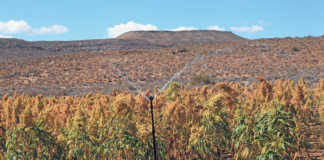As weeds become increasingly resistant to herbicides, farmers will have to adopt strategic or long-term approaches when cultivating their crops. The time has come to consider other alternatives, before resorting immediately to chemical tools. Glenneis Erasmus reports.
Herbicide resistance problems worldwide have escalated dramatically over the past 25 to 30 years. The number of resistant species has increased from 162 to 183 over the past four years alone, according to Jim McDermott from the Herbicide Resistance Action Committee (HRAC). Of these species 110 are broadleaf – compared with 98 four years ago, and 73 are grass leaf species compared with 64 four years ago.
These are, however, only reported cases of resistance and the real state of affairs is believed to be far worse. T he first cases of resistance – which involved pigweed being resistant to triazine and wild oats being resistant to diclopopmethyl – were reported in South Africa in the 1980s.
Prof Andy Cairns from the Department of Agronomy at the University of Stellenbosch believes Africa has some of the most resistant weeds in the world today, with cases of resistance being confirmed for ryegrass (Lolium spp.), wild oats (Avena spp.), ripgut brome (Bromus diandrus), canary seed grass (Phalaris minor), wild radish (Raphaus raphanistrum), pigweed (Amaranthus spp.), chickweed (Stellaria media), and calomba daisy (Pentzia suffruticosa). Resistance is also suspected in wild mustard (Rapistrum rugosum), fumitory (Fumaria murales), musk heron’s bill (Erodium moschatum), and spiny emex (Emex australis).
Financial impact on farmers
The development of resistance is estimated to cost farmers billions of dollars worldwide. According to McDermott, US farmers project that their production costs will rise by US/acre (1ha = 2,5 acres) due to herbicide resistance.
According to Prof Cairns, it is said in Australia that the value of a farm automatically halves if herbicide resistance is confirmed on that specific farm. Willem Hoffman from the Western Cape Department of Agriculture predicts that herbicide resistance could reduce farm earnings by 15% to 25% in the Western if it is not addressed in time. Lower profit margins would have a decimating impact on rural economies dependent on the agricultural sector for income and employment.
Prof Cairns adds that the impact can be even more severe. He knows of farmers who had to resort to using seasonal workers to remove herbicide-resistant weeds in vineyards after exhausting all herbicidal solutions – an untenable, extremely labour-intensive and costly method of removing weeds. Some farmers have had to use more extreme methods of control and had to plough out whole orchards.
Hugh Campbell, horticultural representative of the National Agricultural Research Forum, thinks the problem is still relatively small in the fruit industry. He adds it is highly unlikely that herbicide resistance would have such a large impact on farm earnings as predicted by Hoffman. Even so, herbicide resistance is expected to worsen over time.
Herbicides are relatively cheap, economical and effective in combating weeds in comparison with other means of control. It is not surprising that farmers become dependent on these products. Using the same herbicides over and over, however, can result in reduced efficiency and ultimately leads to herbicide resistance to specific products in some plant species.
Herbicides are not the solution
Relying on agrochemical companies to come to the rescue by developing a new product with a new method of action is futile. “Developing a new chemistry is extremely expensive and it increased from around US0 million to between US0 million and US0 million over the last 10 years due to the stringent environmental impact studies required before a new product can be released,” says Chris Cummings, HRAC chairperson.
The HRAC says a more viable solution is needed. “A holistic approach involving all agricultural role-players throughout the supply chain should be generated. The whole industry should pool funds to combat and research herbicide resistance problems and information should be shared at all levels in the agricultural industry,” Cummings says. Dr Mark Hardy from the Western Cape Department of Agriculture stresses that the industry would have to appoint an individual to oversee and drive a herbicide resistance prevention and awareness programme. The HRAC is a voluntary organisation and all its members are employed by other organisations. Members don’t receive any compensation for their input and the committee does not have the finances or the infrastructure to address the impact of herbicide resistance to the extent it needs to, adds Cummings. The HRAC is therefore taking it upon itself to temporarily coordinate more meetings to incorporate more role-players in the appointment of a permanent representative and strategy to address herbicide resistance in the Western Cape.
Additional data will also be gathered and presented to the University of Stellenbosch and the Western Cape Department of Agriculture to see how these institutions can help to combat the problem through research and dissemination of information. The HRAC hopes the appointment of an individual to oversee herbicide resistance programmes would help to coordinate efforts and effectively channel information back to the industry. There is, however, a serious lack of research and expertise on herbicide resistance. “Something needs to be done to attract more students to this field to find better alternative ways to combat the problem,” Prof Cairns says.
Campbell believes the dissemination of information is the industry’s first priority. He explains farmers would have to take responsibility for the problem as they are at the level most affected.
The benefits of specific farmer action
Farmers will have to adopt a strategic or long-term approach to weed control and resistance management to reduce their dependence on herbicides and to conserve chemical tools for the future, says McDermott. This approach will first result in the alternation of herbicides according to the HRAC Mode of Action chart. “Each product destroys weeds through a specific mode of action. Farmers should aim to alternate between groups and refrain from using chemistry with the same mode of action on the same land more than once a season,” Cummings explains.
Crop rotation is especially important in this regard as it allows producers also to rotate herbicides. Cummings explains that herbicides used on canola cannot be used on wheat, for example, as they destroy grasses. The development of herbicide-resistant crops can also help as it would allow farmers to use herbicides that under normal conditions might be damaging to this species. TT Canola from Australia is an example of such a crop. These crops should, however, still be used in an integrated weed management programme to prevent the development of herbicide-tolerant weeds. Farmers should also use prescribed dosages. Cummings explains the use of higher dosages will enhance the selection pressure for all types of resistance, while lower dosages can lead to metabolic resistance in as little as three years.
Minimising herbicide dependence
Cultivation practices, which include row spacing, plant density, the selection of vigorous crops and those with a high seeding rate to enhance competition with weeds and conventional or conservation planting can all help farmers become less dependent on herbicides. No-tillage, for example, enlarges the number of selective herbicides available for weed control. The herbicide trifluralin, for example, works best when applied in no-tillage. No-tillage should, however, not be seen as the ultimate production method, but only as another management practice to optimise production. Farmers in Australia who under normal conditions would not burn their fields, might now consider strategic burning to combat high weed infestations in problem lands, according to Chad Sauer of Nufarm – a company that manufactures and supplies crop protection products. Sauer says farmers who would never allow animals, such as sheep or cattle, on areas that are under crop production could allow their animals to graze lands after harvesting to reduce the weed seed bank.
This practice should preferably not be followed where farmers experience compaction problems. Weeds can also be collected with a chaff cart or thrown into a windrow during harvesting. The chaff containing weed seed can then either be bailed for animal feed, burned in narrow windrows or moved offsite and be destroyed. Grinders such as rotomills can also be used to destroy weed seeds, and the seeds and chaff can then be spread out over the land and left as mulch. In more severe cases, farmers can make use of fallowing or brown or green manuring. During fallowing, the land is not cultivated for a year and weeds are controlled either chemically, by burning or ploughing weeds into the land before seeds become viable or a combination of these methods. Green and brown manuring entails the normal cultivation of land. During green manuring, seed germination is encouraged and weeds and crops are mowed or cut down before seeds form. The stubble is then either left on or worked back into the soil. Brown manuring is a more extreme method of control. Crops are allowed to grow for six weeks and are then destroyed chemically along with weeds. “Farmers who use these practices will prosper, but those who continue with monocultures and over-reliance on herbicides will struggle,” McDermott predicts.
How does herbicide resistance develop?
There are two primary modes of resistance. The first, called target site resistance, occurs due to a mutation in the gene coding which changes the target enzyme so it is resistant to the herbicide. PJ Pieterse from the Department of Agronomy at the University of Stellenbosch says spraying a plant with target site resistance will have no impact. The second is non-target site resistance which works through various resistance mechanisms that limit the amount of herbicide reaching the target site. For example, the herbicides can be metabolised or degraded before they reach the target site, translocation can be reduced or they can be sequestrated, which means that the herbicide is isolated in the plant, curbing its movement to other molecules in the plant. Weeds with this form of resistance will suffer damage from herbicide applications – but they won’t die. Pieterse says farmers can easily test whether they have resistance to specific products or not. The suspected resistant plants should be planted out and then sprayed to see if there is resistance. However, he stresses that there are huge variations between camps – having resistance in one area therefore does not necessarily mean that there is resistance on the whole farm. Temporal variation can also confound results, according to Pieterse. Weeds such as wild oats – not ryegrass though – can be dormant for four to five years. The resistant weeds might only occur again four years after the diagnosis of herbicide resistance was made. Contact Chris Cummings on 082 908 6001 or e-mail [email protected]. |fw













